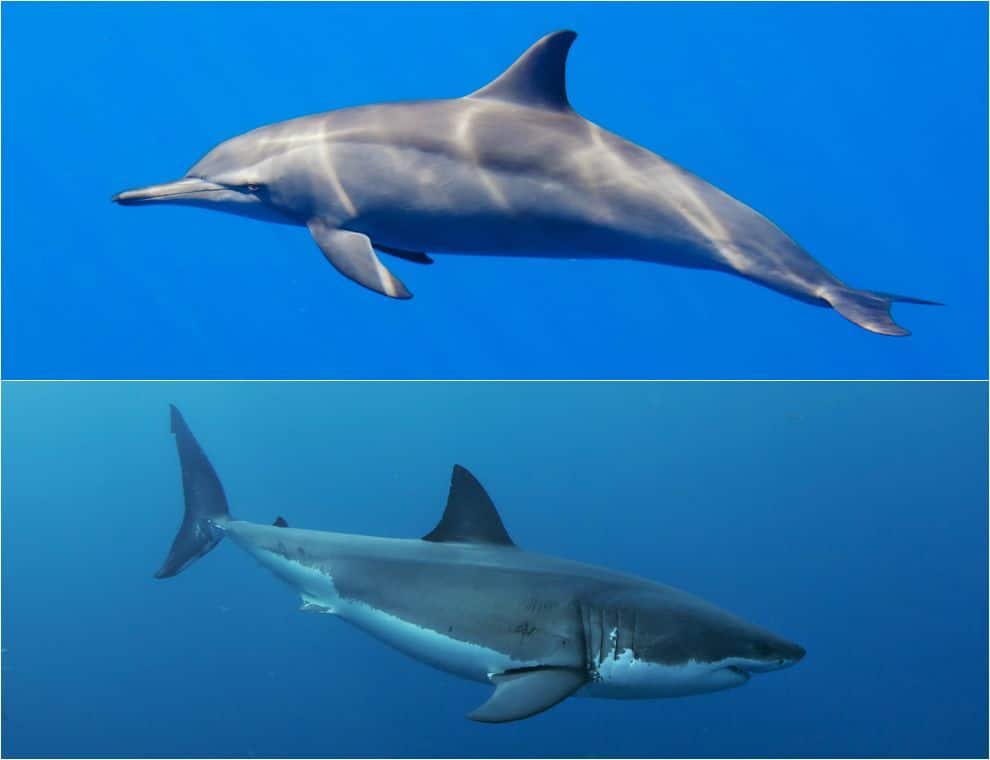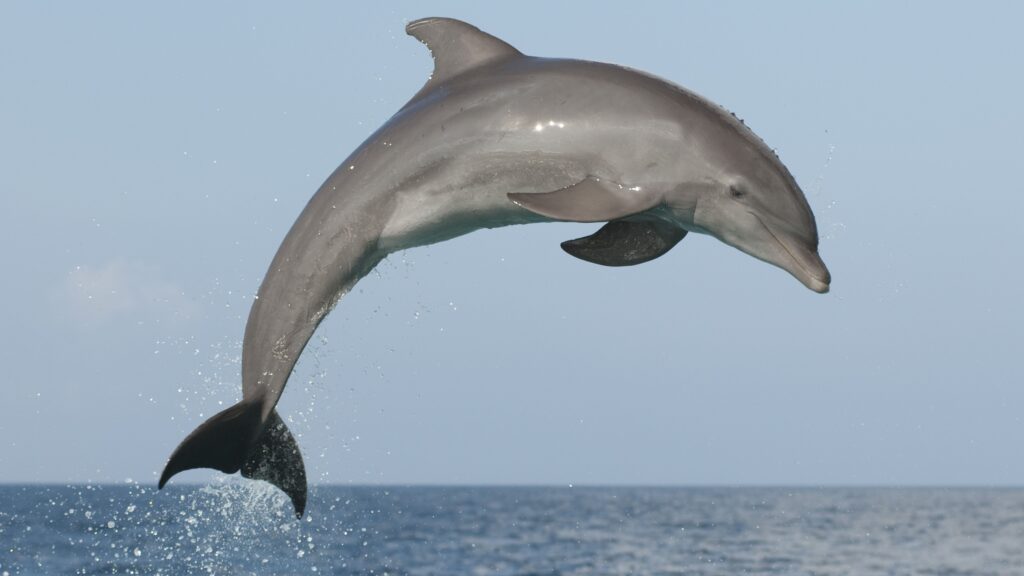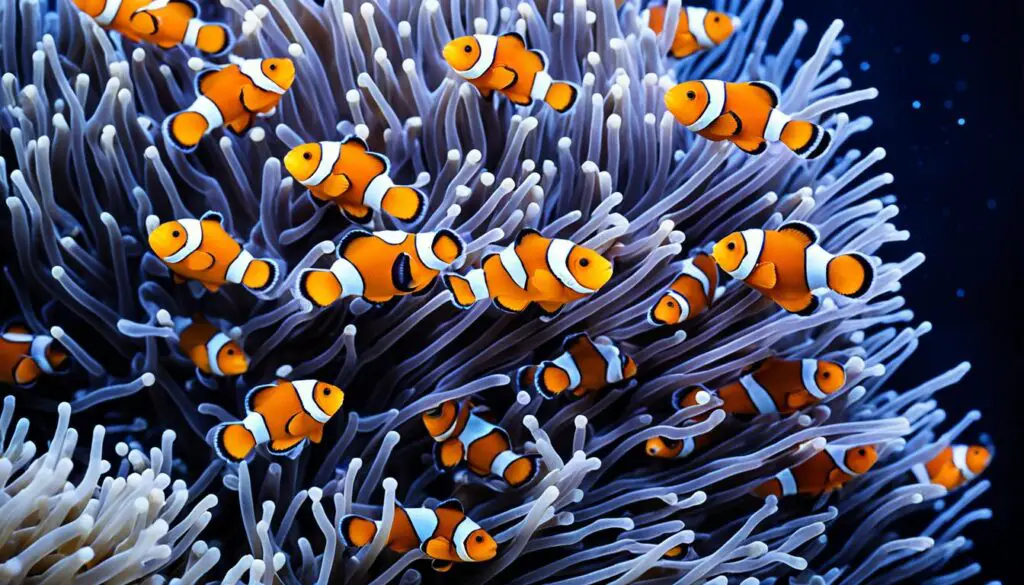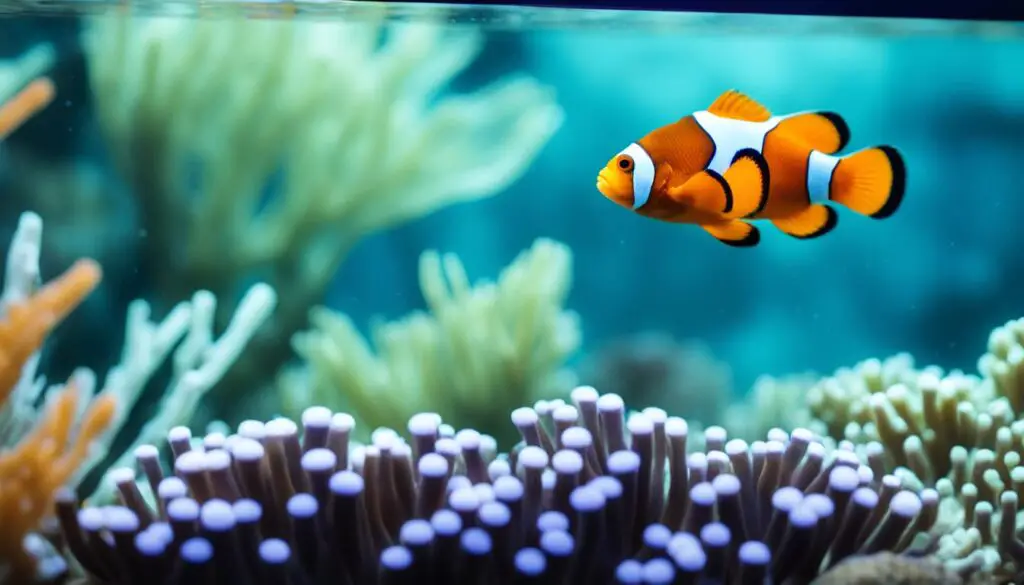What Do Sharks And Dolphins Have In Common

Introduction
What Do Sharks And Dolphins Have In Common: The ocean, Earth’s final frontier, has always captivated our imagination with its mysterious depths and the incredible diversity of life it harbors. Among the many marine creatures that call the ocean home, two groups of animals have consistently captured our attention: sharks and dolphins. On the surface, these creatures might seem like polar opposites, with one being a symbol of fear and the other a symbol of intelligence and playfulness. However, beneath the waves, a deeper understanding reveals surprising commonalities that bind these two groups of marine marvels.
Sharks, with their streamlined bodies and razor-sharp teeth, have long been portrayed as the ruthless predators of the sea. Their ancient lineage dates back hundreds of millions of years, making them some of the oldest inhabitants of the ocean. Dolphins, on the other hand, are celebrated for their remarkable intelligence, sociable behavior, and acrobatic displays. They are often associated with joy and wonder, captivating humans with their playful antics.
Despite these apparent differences, sharks and wild dolphins share a myriad of intriguing similarities that are often overshadowed by their contrasting images. Both groups are essential components of marine ecosystems, playing vital roles in maintaining the balance of the oceans. Their remarkable adaptations have enabled them to thrive in the world’s most challenging environments, from the frigid waters of the Arctic to the warm tropical seas.
In this exploration, we will dive beneath the surface to uncover the surprising commonalities that unite sharks and dolphins. From their evolutionary history and astonishing adaptations to their ecological importance and ongoing conservation efforts, we will unravel the intricate web of connections that exist between these two enigmatic creatures. Join us on a journey into the depths of the ocean as we discover what sharks and dolphins truly have in common.

Why are dolphins and sharks so similar?
We know that dolphins and sharks are not closely related, and they didn’t inherit their similar body shapes from a common ancestor. Their streamlined bodies, dorsal fins and flippers are the result of convergent evolution.
Dolphins and sharks exhibit remarkable similarities in certain aspects, despite belonging to different biological classes (mammals and fish, respectively). These similarities arise from a fascinating evolutionary phenomenon known as convergent evolution, driven by the selective pressures of their shared marine environments.
Firstly, both dolphins and sharks have evolved streamlined body shapes over millions of years. This streamlined design reduces water resistance, enabling them to glide efficiently through the water. This adaptation is essential for catching prey and conserving energy during long-distance oceanic travels. The similar need for hydrodynamic efficiency in their environment led to the convergence of body shapes in these two groups.
Secondly, both dolphins and sharks possess a range of highly developed sensory organs. Sharks have an acute sense of smell, detecting even trace amounts of blood in the water, while dolphins rely heavily on echolocation for navigation and hunting. These sensory adaptations are the product of parallel evolution, where different species develop similar traits independently in response to comparable ecological challenges.
Additionally, both groups are characterized by their predatory lifestyles. Dolphins are known for their intelligence and cooperative hunting strategies, while sharks are often considered the iconic oceanic predators. These shared roles as top predators reflect the necessity of efficient hunting and the importance of maintaining balanced marine ecosystems.
In summary, the remarkable similarities between dolphins and sharks can be attributed to convergent evolution, where unrelated species adapt similarly to the challenges presented by their shared marine environments. This convergence has resulted in streamlined body shapes and specialized sensory adaptations that enable both groups to thrive in the vast and dynamic oceans.
What is one similarity and one difference between sharks and dolphins?
They slice through the water to grab their prey with sharp teeth. But despite their similarities, sharks and dolphins belong to different animal classes: one is a fish and gets oxygen from the water and the other is a mammal and gets oxygen from the air.
One striking similarity between sharks and dolphins is their adaptation to life as top predators in the marine food chain. Both groups occupy apex predator roles within their respective ecosystems, exerting significant control over the populations of other marine species. This shared ecological role means that both sharks and dolphins play crucial roles in maintaining the balance and health of the oceanic ecosystems they inhabit. They help control the populations of prey species, preventing overpopulation that could otherwise disrupt the marine food web.
However, a notable difference between sharks and dolphins lies in their classification within the animal kingdom. Sharks belong to the class Chondrichthyes, a group of cartilaginous fish, while dolphins are mammals belonging to the order Cetacea. This fundamental distinction means that sharks are cold-blooded fish, while dolphins are warm-blooded mammals, with unique physiological differences such as reproductive methods, respiratory systems, and thermoregulation strategies.
In summary, the similarities between dolphins and sharks can be attributed to convergent evolution driven by the demands of their shared marine environment and predatory roles. They both have streamlined bodies for efficient swimming and serve as apex predators, maintaining marine ecosystem health. However, a fundamental difference is their classification: sharks are cartilaginous fish, while dolphins are warm-blooded mammals, each with distinct biological characteristics that set them apart in the animal kingdom.
What relationship do sharks and dolphins have?
To say that dolphins and sharks hate each other is oversimplifying their relationship. They are more like acquaintances who prefer not to interact unless necessary. Let’s agree to call them frenemies. You might have heard stories about dolphins “protecting” a human against a shark attack.
Sharks and dolphins share a complex and often multifaceted relationship in their shared marine environments. The nature of their interactions can vary widely depending on factors such as the specific species involved, the ecological context, and the availability of food resources. Here, we explore the various dimensions of the relationship between sharks and dolphins:
Coexistence: Sharks and dolphins often coexist in the same oceanic regions due to their shared preference for areas rich in prey. Both species are attracted to places where food sources are abundant, such as schools of fish and squid. In these circumstances, they can sometimes be seen swimming in close proximity to one another without overt signs of aggression or competition.
Competition: While they share similar diets, sharks and dolphins can also compete for the same food resources. This competition can sometimes lead to conflicts, particularly in situations where prey is limited. Sharks, with their keen sense of smell, can detect the presence of dolphins when they hunt, and vice versa, potentially creating tension as they vie for the same prey.
Predator-Prey Relationship: In some cases, dolphins may become prey for certain shark species. While dolphins are known for their intelligence and agility, some shark species are formidable predators with specialized hunting tactics. However, such interactions vary widely depending on the specific dolphin and shark species and their respective sizes.
Mutual Benefit: There have been observations suggesting that dolphins and certain shark species, like the oceanic whitetip shark, may engage in mutually beneficial interactions during feeding events. Dolphins may help drive prey towards sharks, and in turn, the sharks benefit from the dolphins’ herding behavior.
In summary, the relationship between sharks and dolphins in the marine ecosystem is intricate and dynamic. While they share common habitats and compete for similar food resources, the nature of their interactions can range from coexistence to competition and even predator-prey relationships. The specifics of their relationship depend on numerous factors, highlighting the complexity of predator-prey dynamics in the world’s oceans.
What do sharks and dolphins eat in common?
Both sharks and dolphins are opportunistic feeders, meaning they eat whatever is available and easiest to catch, and carnivores. Their diets can include fish, crustaceans, squid, and shrimp.
Sharks and dolphins, despite their differences, share some common dietary preferences due to their overlapping habitats and roles as apex predators in the marine food chain. Both groups primarily feed on a variety of marine organisms found in the ocean, although there are differences in their specific diets.
Fish: Both sharks and dolphins are known to consume various species of fish as a significant portion of their diets. They often target schools of small fish like sardines, herring, mackerel, and anchovies. This preference for fish is a shared feature that reflects their position as carnivorous hunters in the marine ecosystem.
Squid: Another common dietary item for both sharks and dolphins is squid. These cephalopods are abundant in many oceanic regions and are a valuable source of nutrition. Sharks and dolphins have developed different hunting strategies for capturing squid, with dolphins often using their speed and agility, while some shark species employ stealth and ambush tactics.
Crustaceans: While fish and squid are primary components of their diets, some sharks and dolphins may also consume crustaceans such as crabs and shrimp when opportunities arise. Crustaceans are an occasional but noteworthy part of their diets, particularly for certain dolphin species.
Other Marine Organisms: Both sharks and dolphins have been observed eating other marine organisms, including smaller sharks and rays, as well as various types of smaller prey like krill and other planktonic organisms. The specific prey items can vary depending on the region, habitat, and the availability of food sources.
It’s important to note that while sharks and dolphins share these common dietary items, their hunting techniques and preferences can differ significantly based on their species, size, and ecological niches. Dolphins, known for their intelligence and cooperative hunting behavior, may use advanced strategies like herding fish into tight groups for easier capture. Sharks, on the other hand, often rely on stealth, speed, and sharp teeth to seize their prey. These shared dietary items underscore the vital role both sharks and dolphins play in maintaining the balance of marine ecosystems as top predators.
Is it true that sharks don’t like dolphins?
In conclusion, the combination of dolphins’ intelligence, physical abilities, and social structure, as well as their potential to produce an electrical field, makes them formidable predators in the ocean, and this is why sharks are often so afraid of them.
The idea that sharks inherently dislike dolphins or engage in aggressive behavior towards them as a general rule is not entirely accurate. While there are occasional reports of interactions between sharks and dolphins that involve aggression or predation, it is essential to understand that these interactions are complex and can vary widely based on several factors.
Species-Specific Behavior: Different species of sharks and dolphins exhibit distinct behaviors and interactions. Some species may coexist peacefully, while others may exhibit more aggressive tendencies. For instance, certain shark species, like the great white shark, have been observed preying on dolphins, but such interactions are not representative of all shark-dolphin encounters.
Competition for Resources: Sharks and dolphins may sometimes compete for the same prey species, leading to occasional conflicts or competitive behaviors. Both groups are carnivorous predators and seek out schools of fish and other marine organisms as primary food sources, which can create overlapping interests.
Context Matters: The context of the interaction matters significantly. Sharks and dolphins may share common habitats and interact for various reasons, including hunting, mating, or even socializing. These interactions can range from neutral to aggressive, depending on the specific circumstances and the individuals involved.
Individual Variability: Just like any other animals, individual sharks and dolphins have their own behaviors and personalities. Some individuals may be more inclined to engage in aggressive behaviors, while others may prefer to avoid conflicts altogether.
Observations and Research: Scientific studies on shark-dolphin interactions have revealed a wide range of behaviors and outcomes. While some interactions may result in predation, others involve dolphins defending themselves or forming protective groups when encountering sharks.
In summary, while there are instances of sharks and dolphins having less than harmonious interactions, it is not accurate to claim that sharks inherently dislike dolphins. The nature of their encounters is influenced by a combination of factors, including species, context, and individual variability. Sharks and dolphins, like other animals, engage in a variety of interactions within the complex dynamics of marine ecosystems, and these interactions can vary widely.
Who is more powerful shark or dolphin?
A shark would win in a fight against a dolphin. They are faster, larger, and more attuned to predation than others. Furthermore, their mouths are actually large enough to bite down on a dolphin and deal fatal damage.
The question of whether sharks or dolphins are more powerful is not straightforward, as power in the context of marine animals can be assessed in various ways, and it often depends on the specific aspects being considered.
Physical Strength: In terms of sheer physical strength and bite force, sharks are generally considered more powerful. Many shark species have incredibly strong jaws with rows of sharp teeth designed for tearing through flesh and bone. The great white shark, for example, possesses one of the most formidable bite forces in the animal kingdom, allowing it to take down large prey.
Speed and Agility: Dolphins, on the other hand, are known for their exceptional speed and agility. They are among the fastest swimmers in the ocean, capable of reaching speeds of up to 60 kilometers per hour (37 miles per hour). This speed and agility make dolphins powerful hunters, allowing them to chase down and capture swift prey like fish and squid.
Intelligence and Cooperative Behavior: Dolphins are renowned for their intelligence and complex social structures. They often work together in coordinated groups to hunt, protect their young, and navigate their environment. This cooperative behavior can give them an advantage in certain situations, allowing them to outmaneuver or outsmart potential threats.
Predatory Adaptations: Sharks are well-adapted predators with keen senses, including an acute sense of smell, which helps them locate prey from great distances. This sensory advantage contributes to their hunting prowess and power as apex predators.
Ecological Roles: Both sharks and dolphins play crucial ecological roles in their respective habitats. Sharks help regulate prey populations, preventing overpopulation of certain species, and thus contribute to maintaining the health of marine ecosystems. Dolphins, through their hunting strategies and social interactions, also impact the balance of marine food webs.
In summary, the assessment of who is more powerful between sharks and dolphins depends on the specific criteria being considered. Sharks have powerful physical attributes and hunting abilities, while dolphins excel in terms of speed, agility, and complex social behaviors. Both animals are highly adapted to their respective roles in the marine ecosystem and are considered apex predators in their own right. Comparing their power is less meaningful than understanding their unique strengths and roles within their ecosystems.
Are sharks as smart as dolphins?
Sharks vs dolphins is a classic battle of brawns vs brains. Dolphins’ biggest advantage over sharks’ strength is their intelligence. Using echolocation, Dolphins can quickly navigate through water to avoid or attack sharks.
Sharks and dolphins are both highly evolved and adapted marine animals, but they exhibit different types of intelligence and have distinct behaviors.
Dolphins are known for their high levels of intelligence and complex social behaviors. They have large brains relative to their body size and are capable of problem-solving, tool use, communication through a sophisticated system of clicks and whistles, and even showing signs of self-awareness. Some species of dolphins, such as bottlenose dolphins, are particularly well-studied and have demonstrated remarkable cognitive abilities.
On the other hand, sharks have a different type of intelligence. While they may not display the same level of problem-solving or social complexity as dolphins, they are highly skilled predators with specialized sensory adaptations. Sharks have an acute sense of smell, can detect electrical signals produced by other animals, and have remarkable navigational abilities. They are also skilled at hunting and have evolved various hunting strategies over millions of years.
Comparing the intelligence of sharks and dolphins is challenging because they have evolved to thrive in different ecological niches, and their behaviors and cognitive abilities are adapted to their specific lifestyles. Dolphins are more social and have complex social structures, while sharks are solitary hunters.
In summary, while dolphins are often considered more intelligent in terms of problem-solving and social complexity, sharks possess their own form of intelligence that is well-suited to their ecological roles as apex predators in the ocean. It’s essential to appreciate and study the unique cognitive abilities and behaviors of both species within the context of their respective environments and lifestyles.
Is shark afraid of dolphins?
Sharks are often viewed as one of the ocean’s top apex predators, but despite this rather prestigious classification, there’s one marine animal that most sharks prefer to avoid crossing paths with entirely: the bottlenose dolphin.
Sharks and dolphins are both apex predators in the marine ecosystem, and their interactions can vary depending on the species involved and the circumstances. In some cases, dolphins have been observed interacting aggressively with sharks, but it’s not accurate to say that sharks are universally afraid of dolphins.
Here are a few scenarios regarding interactions between sharks and dolphins:
Predatory Interactions: Some species of dolphins, such as bottlenose dolphins, are known to be aggressive towards sharks when they perceive them as a threat to their group or territory. Dolphins may use their agility, speed, and cooperative behavior to chase away or attack a shark.
Mixed-Species Associations: In some regions, dolphins and sharks have been observed swimming together without showing signs of aggression. This association can be mutualistic, as dolphins may benefit from the shark’s ability to locate prey, and the shark may have a chance to scavenge on leftover food from the dolphins.
Avoidance: In other cases, both dolphins and sharks may simply avoid each other if there is no perceived threat or benefit to interacting.
Species Variability: It’s important to note that the behavior of both dolphins and sharks can vary greatly depending on the species involved. Some dolphin species may be more prone to aggressive behavior toward sharks, while others may be more passive.
Ultimately, the relationship between sharks and dolphins is complex and can’t be generalized. It depends on a variety of factors, including the species of each animal, the specific circumstances, and the availability of food. While dolphins may sometimes exhibit aggression toward sharks, it’s not accurate to say that sharks are universally afraid of dolphins.

Conclusion
In the depths of the ocean, where sunlight struggles to penetrate, sharks and dolphins have emerged as two remarkable groups of marine animals that share a profound connection, despite their contrasting reputations. As we conclude our exploration into what these creatures have in common, we are left with a profound appreciation for the intricate tapestry of life that exists beneath the waves.
One of the most striking commonalities between sharks and dolphins is their adaptability. Over millions of years of evolution, both groups have developed extraordinary features that allow them to thrive in diverse oceanic environments. Sharks have perfected their predatory prowess with sleek bodies and an array of finely tuned senses, while dolphins have harnessed their intelligence, social bonds, and echolocation abilities to navigate and communicate in the vast, dark expanses of the sea.
Furthermore, both sharks and dolphins play pivotal roles in maintaining the ecological balance of our oceans. As apex predators, sharks regulate the populations of other marine species, preventing the overgrowth of certain populations that could disrupt the delicate equilibrium of marine ecosystems. Dolphins, with their intelligence and intricate social structures, contribute to the health of the oceans by ensuring the survival of their prey species and promoting a thriving marine environment.
In a world where the oceans face numerous threats, from habitat destruction to overfishing and climate change, the conservation of sharks and dolphins related has never been more critical. Their shared vulnerability to these global challenges highlights the importance of concerted efforts to protect their habitats and populations.
As we reflect on what sharks and dolphins have in common, we are reminded that these creatures are not only integral to the health of our oceans but also symbolic of the wonder and complexity of marine life. They challenge our perceptions and encourage us to appreciate the intricate relationships that sustain life in the vast blue expanse of our planet. In their unity, we find inspiration to continue our efforts to conserve and safeguard the oceans, ensuring that these remarkable creatures continue to grace our seas for generations to come.



